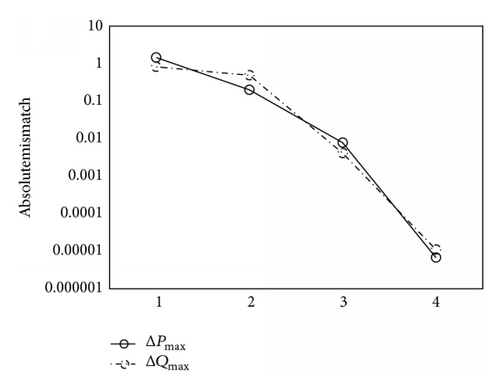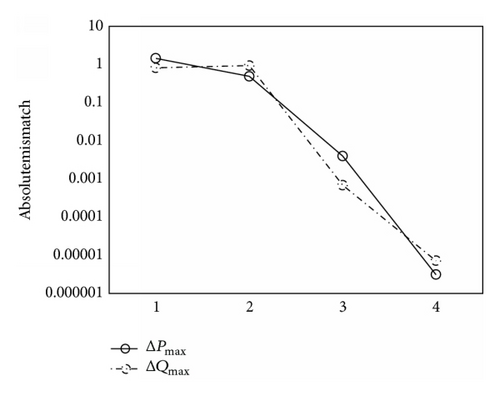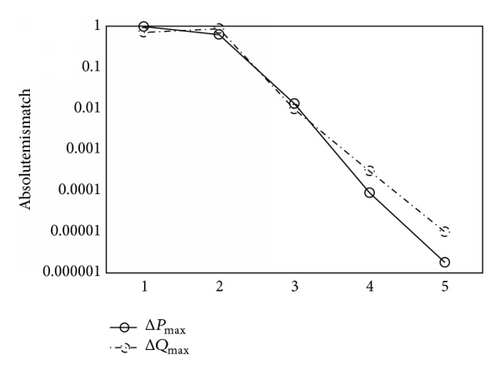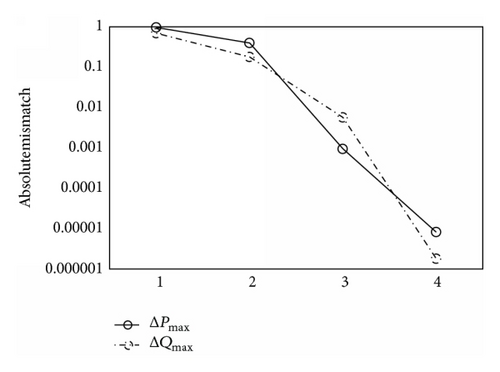Improvement of Power Flow Calculation with Optimization Factor Based on Current Injection Method
Abstract
This paper presents an improvement in power flow calculation based on current injection method by introducing optimization factor. In the method proposed by this paper, the PQ buses are represented by current mismatches while the PV buses are represented by power mismatches. It is different from the representations in conventional current injection power flow equations. By using the combined power and current injection mismatches method, the number of the equations required can be decreased to only one for each PV bus. The optimization factor is used to improve the iteration process and to ensure the effectiveness of the improved method proposed when the system is ill-conditioned. To verify the effectiveness of the method, the IEEE test systems are tested by conventional current injection method and the improved method proposed separately. Then the results are compared. The comparisons show that the optimization factor improves the convergence character effectively, especially that when the system is at high loading level and R/X ratio, the iteration number is one or two times less than the conventional current injection method. When the overloading condition of the system is serious, the iteration number in this paper appears 4 times less than the conventional current injection method.
1. Introduction
Power flow studies are necessary for planning, operating, economic scheduling, and other analysis, such as transient stability, voltage stability, and contingency studies. The tasks of power flow calculation are to solve the steady-state operating conditions of power systems based on the operation modes and the wiring of the systems. Different power flow methods have emerged and continue to be developed with the changing needs.
The conventional power flow solution comprises power equations expressed in terms of rectangular or polar coordinates. Many important contributions have been reported in this area [1–3]. To improve the convergence characteristic of Gauss-Seidel method, the Newton-Raphson method was introduced. The NR method was once considered the state of the art power-flow technique and widely accepted in industry applications. However, the main disadvantage of the Newton-Raphson method is the necessity for factorizing and updating the Jacobian matrix during the iterative solution process [4]. To solve this problem, Fast Decoupled power flow method was proposed to speed up the iteration process of the NR method and decrease the required minimum memory storage. Nevertheless, the convergence rate of the decoupled NR is influenced by the ill-conditioned case, such as when a system has high ratio of line R/X [5–8]. Some other methods have been presented in other forms, such as the use of sequence component frame [9–11] and the method based on the loop frame of reference [12].
In [13], a new power flow method based on current injection was presented, in which the current injection equations are written in rectangular coordinates. The Jacobian matrix is composed of 6 × 6 block matrices and has the same structure as the nodal admittance matrix. By using this method, the Jacobian matrix can be updated faster than using conventional NR power flow method in the case of PQ buses. However, in the case of the existence of PV buses, the current injection mismatch power flow method was presented to improve the convergence character of current injection method [14, 15]. The improvement in [16] increased the number of required equations to three for each PV bus. The paper [17] presented a new representation of PV buses in revised current injection power flow method to reduce the number of required equations and to improve the convergence character of well- and ill-conditioned systems, while the elements related to PV buses have to be changed during the iteration process. In [18] a development of power flow calculation for ill-conditioned system was presented. The fact that “the Taylor series expansion of the load flow equations is expressed up to the third term completely and the final term has the same form but different variable as the first term” was used in [18]. Following the main ideas presented in [18], which is called Iwamoto’s method in [15], a new second order power flow method was proposed. This method is useful for heavily loaded and overloaded systems as well as ill-conditioned distribution systems.
This paper improved the current injection method presented in [17] following the main idea in [18]. The optimization presented in [18] is briefly described here firstly to make the paper clear. Then the improved method, results, and conclusions are presented.
2. Current Injection Power Flow
where ΔIrk: real parts of current mismatch at bus k, ΔImk: imaginary parts of current mismatch at bus k, ΔPk: active power mismatch at bus k, ΔVrk: real voltage component correction at bus k, ΔVmk: imaginary voltage component correction at bus k, and Δδk: voltage angle correction at bus k.
2.1. Equations for PQ Buses
2.2. Representation of PV Buses
In the Jacobian matrix of (1), the elements related to buses of PV type are given as follows.
3. Description of Iwamoto’s Method
4. Improvement in Current Injection Method
4.1. Parameters for PQ Buses
4.2. Parameters for PV Buses
5. Results
This paper used MATLAB to implement the program of power flow method proposed. IEEE 30-bus and 118-bus test system are tested here. Firstly the validity of the improved method proposed is proven. Here the systems are tested as symmetrical systems. Tables 1 and 2 show a part of the results. Then the results obtained by conventional current injection and the improved method proposed, respectively, are compared. Figures 1 and 2 show the iteration characteristics of IEEE 30-bus test system using the two different methods and Figures 3 and 4 show the results of IEEE 118-bus system in the same way.
| Bus | Type | Voltage (p.u.) | θk (°) |
|---|---|---|---|
| 1 | 0 | 1.0500 | 0.0000 |
| 5 | 2 | 1.0100 | −6.5044 |
| 13 | 2 | 1.0500 | −6.3295 |
| 20 | 1 | 1.0183 | −9.4974 |
| 29 | 1 | 0.9972 | −10.6400 |
- 0—slack bus, 1—PQ bus, 2—PV bus.
| Bus | Type | Voltage (p.u.) | θk (°) |
|---|---|---|---|
| 1 | 2 | 0.9550 | −7.7063 |
| 10 | 2 | 1.0500 | 16.2400 |
| 26 | 2 | 1.0500 | 8.4671 |
| 43 | 1 | 0.9632 | −8.6993 |
| 57 | 1 | 0.9714 | −3.2338 |
| 65 | 2 | 1.0050 | 5.1198 |
| 69 | 0 | 1.0350 | 0.0000 |
| 87 | 2 | 1.0150 | 14.7054 |
| 99 | 2 | 1.0100 | 6.3423 |
| 116 | 2 | 1.0050 | 3.9203 |
- 0—slack bus, 1—PQ bus, 2—PV bus.




Tables 3 and 4 compare the conventional current injection method and the improved method proposed here when the system has high R/X ratios and compare the two methods when the system is operating in overloaded condition.
| R/X ratio | Method | |
|---|---|---|
| Conventional current injection method | The improved method proposed | |
| 0.5 | 2 | 2 |
| 1 | 2 | 2 |
| 4 | 3 | 3 |
| 6 | 4 | 3 |
| 8 | 6 | 4 |
| Loading | Method | |
|---|---|---|
| Conventional current injection method | The improved method proposed | |
| 1 | 2 | 2 |
| 4 | 3 | 2 |
| 6 | 5 | 3 |
| 10 | 8 | 4 |
| 15 | No convergence | 6 |
(a) Validity of the Method. Tables 1 and 2 show the results of the iteration and present the validity of the improved method. The voltage amplitudes and angles are reasonable and acceptable. At the same time the feasibility of the method is proved.
(b) Convergence Characteristic. The iteration convergence criterion for the program of the improved method proposed is that the maximum active power mismatch and the maximum reactive power mismatch are both less than the tolerance. The results presented in Figures 1–4 show that the convergence characteristic of the improved method proposed is better than the conventional current injection method.
(c) High R/X Ratio. Many power flow methods always have bad convergence characteristic if the system has high R/X ratio. In Table 3 the R/X ratios are divided into five levels. When the system has high X/R ratio, both the two methods have good convergence characteristic, but with the increase of R/X ratio the advantage of the improved method proposed becomes obvious; the iteration number is one or two times less than the conventional current injection method.
(d) Overloading. The comparison of the iteration number for different loading cases is shown in Table 4. In this case the system is in overloading condition. In Table 4, five loading cases are presented. There has been little difference between the two methods when the overloading of the system is not serious. However, when the condition becomes more serious the iteration number of the improved method proposed appears 4 times less than the conventional current injection method. Even more, when the convergence characteristic of the improved method proposed is still acceptable when overloading is serious, the conventional current injection method shows no convergence.
6. Conclusions
This paper has presented improvement in power flow calculation based on current injection method by introducing an optimization factor. Unlike other current injection methods, the PV buses are represented by power mismatches here. The results have demonstrated the good performance of the improved method proposed in this paper. By using optimization factor the iteration character got improved. Even when the system has high R/X ratio or operates in overloaded conditions, good results could be got by using this method.
Conflict of Interests
The authors declare that there is no conflict of interests regarding the publication of this paper.
Acknowledgments
This work was supported in part by the National Natural Science Foundation of China (no. 51205046) and the Fundamental Research Funds for the Central Universities (nos. CDJZR170008, 106112014CDJZR175501). The constructive comments provided by the anonymous reviewers and the editors are also greatly appreciated.




